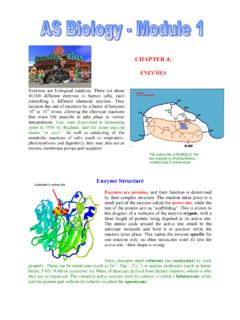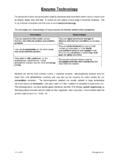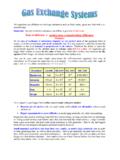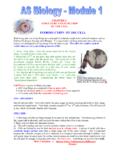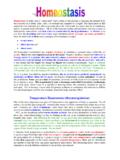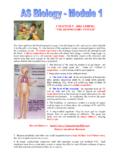Transcription of General Properties Protein Nature of Enzymes - …
1 Proteins that function as biological catalysts are called Enzymes . Enzymes speed up specific metabolic reactions. Low contamination, low temperature and fast metabolism are only possible with Enzymes . Metabolism is fast, with the product made to a high degree of purity. General Properties Catalysts Protein Specific Reversible can catalyse the reaction in both directions Denatured by high temperature and change in pH. Rate of action affected by temperature and pH. Protein Nature of Enzymes Composed of C, H, O and N. Sulphur (S) may also be present.
2 One or more polypeptide chains - large number of linked amino acids. Formed on the ribosomes (70s, 80s) translation of mRNA during Protein synthesis. Denatured by high temperature and unfavourable pH. Folded Shape of Enzymes The polypeptide chains are folded into a particular three-dimensional shape (H-bonds). The correct folded shape is essential for enzyme action tertiary structure'. The shape gives the enzyme special areas known as active sites. The compatible substrate molecules bind to the complementary active site. Different Enzymes have a differently shaped active site.
3 REMEMBER: enzyme-substrate complex'; active site';. Higher temperatures = more kinetic energy, so more collisions Induced fit' means enzyme and substrate both get distorted; bonds bent, so reaction faster. Role of Enzymes in Living Things: Enzymes catalyse all metabolic reactions. They lower the activation energy the energy input needed to bring about the reaction. Regulate the thousands of different metabolic reactions in a cell and in the organism. The activity of a cell is determined by which Enzymes are active in the cell at that time.
4 Cell activity is altered by removing specific Enzymes and/or synthesising new Enzymes . Active Site Theory Lock and Key Hypothesis and Induced Fit . The enzyme's active site has a shape complementary to the substrate. The substrate locks into the active site of the enzyme. The active site alters its shape holding the substrate more tightly and straining it. An enzyme-substrate complex is formed. The substrate undergoes a chemical change a new substance (product) is formed. The product is released from the active site. The free unaltered active site is ready to receive fresh substrate.
5 Denatured Enzyme: an enzyme that cannot operate because the shape of its active site is altered thus the substrate cannot combine with it change in shape resulting in loss of biological function. Denaturation Heat is a form of energy. The addition of heat can cause a change in the tertiary structure of a Protein (mainly by breaking H-bonds). The new shape results in a change in the chemical Properties of the Protein . The Protein is denatured if the shape change causes it to lose its normal biological activity. Heat-induced denaturation is not usually reversible.
6 PH-induced denaturation is usually reversible Factors Affecting Enzyme Action Enzyme action occurs when the enzyme and substrate collide enzyme-substrate complex'. During the collision the substrate slots into the active site of the enzyme. Collisions happen because of the rapid random movement of molecules in liquids. (i) Temperature at 0 C enzyme action is low because the movement of molecules is low the collision frequency between enzyme and substrate is therefore low increasing the temperature speeds up the movement of molecules ( > kinetic energy).
7 More enzyme-substrate complexes' are formed therefore enzyme action increases maximum enzyme action at 40 C - maximum collision frequency between active Enzymes and substrates enzyme action decreases above 40 C because the Enzymes are denaturing more quickly when all the Enzymes are denatured enzyme action stops (>60oC). (ii) pH. enzyme action is greatest within a narrow range of pH, because: all the Enzymes are active changing pH changes H-bonds, thus shape of the active site therefore substrate can no longer bind to the active site and so enzyme action decreases a major pH change denatures the enzyme so enzyme action stops Optimum Enzyme Activity Enzymes function best within a narrow range of temperature and pH.
8 Human intracellular Enzymes work best at 37 C and pH 7. Industrial Uses of Enzymes Bioprocessing is the use of biological materials (organisms, cells, organelles, Enzymes ) to carry out manufacturing or treatment procedures of commercial or scientific interest. Examples include: Glucose isomerase: production of fructose from glucose (sweeter). Sucrase: production of glucose and fructose from sucrose (much sweeter). Glucose oxidase: testing of blood/urine for glucose (diabetics). Pectinase: production of clear juice from apples/grapes etc for cider/wine-making Immobilised Enzymes are not free in solution they can be held in a bead of soft permeable gel or coat the internal surface of a porous solid.
9 Advantages of Immobilised Enzymes Easier purification of the product as the separation of the enzyme beads is not a problem. Easy to recover and recycle the Enzymes more economical process. The Enzymes remain functional for much longer as it is a gentler process Therefore cheaper Best to use thermostable Enzymes as these o last longer o and work at higher temperature, thus faster Bioprocessing Procedure Bioprocessing with immobilised Enzymes is carried out in a bioreactor. The gel beads, with the immobilised Enzymes , are held in suspension in the nutrient medium.
10 The bioreactor is sterile micro-organisms would o contaminate the product and o reduce yield. Temperature, pH, substrate and product concentration and waste level are checked constantly (computer). The product can be produced by continuous flow (better) or by batch processing. Practicals To Determine the Effect of pH on the Rate of Enzyme Action. Substrate: starch. Enzyme: amylase . Use the same volume of the same substrate and enzyme solutions. Temperature at 37 C: heated water bath and thermometer. Different pH values: use buffer solutions pH 3, pH 5, pH 7, pH 9, pH 11.
